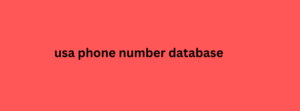Marketing automation has advanced with the development of artificial intelligence (AI), shifting from rule-based .
90% of marketing professionals use to automate customer interactions while 88% say the technology has helped them personalize the customer journey across.
In this blog, we examine 7 key ways you can use
marketing automation to optimize your marketing efforts.
1. Predictive Analytics & Customer Segmentation
The most powerful element of AI is how it can analyze huge amounts of data.
For example, you could get insights into customer phone number list behavior by analyzing past purchases. This can be done on an individual level to see if there’s a pattern: for example to see if an interaction was triggered by an email or if it was due to a promotion on social media.
These insights can help you segment customers basedr interests and predict future
. With this knowledge, you can target customer segments at the right time with the right offer on the most likely channel to convert.
Brand example – Natural Cycles
Natural Cycles is a birth control app that uses an algorithm to gauge a woman’s fertility status based on body temperature.
To get more granular in its targeting and create more personalized messages with users, they used the AI-powered marketing automation platform .
, the app could tailor messages to each customer category. They could also schedule more campaigns in less time and with fewer people.
2. Hyper-Personalized Content & Recommendations
has shaken up the marketing world, particularly for those creating content or companies wanting to create content formats at scale.
Many other tools are now on the market, including Claude, Perplexity, Google, and all able to create content based on clear prompts.
Recent advances in text, image, and video generation help product descriptions, or email campaigns. Cloud Express and can help marketers generate graphics from text prompts.
Some marketers are even creating content that adapts in real-time and responds to context and audience sentiment to enable hyper-personalization.
Brand example – Spotify
relies on AI algorithms to build playlists and artist recommendations based on a user’s listening activity.
This means the audio streaming service can provide America Email List customers with more of the music they love and recommendations based on their taste.
Spotify also has an AI-powered DJ for premium subscribers and a pilot AI voice translation for podcasts.
3. Chatbots & Conversational AI
By leveraging conversational AI, businesses across industries can provide more personalized and efficient customer service and free up the time and resources of their human agents.
That’s why, according to Gartner research, chatbots will become the primary customer service
And are evolving. AI chatbots with advanced NLP can handle complex queries and adapt responses
Brand example – Lemonade Insurance
Digital insurance company developed a chatbot, named Maya, to guide users navigating the insurance-buying process.
Maya can collect information, provide quotes, lead generation: what it is, how to start and 10 examples of irresistible lures and handle payments. The bot makes sure the customer gets insurance within 90 seconds and paid within three minutes.
Maya also chats with customers to provide customized answers to difficult questions but helps the company make changes to existing policies. As a machine learning system.
that Maya now handles a quarter of their inquiries and has sold 1.2M insurance policies in just three years from its launch.
4. Improved Campaign Optimization & Performance Measurement
The ability to optimize a campaign and monitor its performance is crucial for marketers. While this could be a laborious process, AI-driven tools can not only track KPIs but they also provide real-time feedback and actionable insights.
With this level of understanding, marketers can optimize campaigns to discover the top performing channel .
There are also AI tools that can automatically adjust campaigns based on KPIs like engagement. Brand example – The North Face
Exploration brand, North Face wanted to understand what consumers looked for in each market to optimize the consumer experience to those preferences. The company often does this by constantly monitoring how consumers search for items on its website.
By using in combination with Analytics 360, the brand discovered that their customers were searching for a new term – “midi parka.” To tap into this, the company renamed one of its products and drove a 3X increase in conversions and revenue.
5. Lead Scoring & Enhanced Sales Automation
According to Salesforce’s 98% of sales teams think automated lead scoring improves lead prioritization
AI lead scoring uses algorithms to track and assess user or client interactions. This information is then used by the AI scoring model to forecast which leads will result in more profitable sales or clients and can improve handoff to sales teams.
Sales teams can also automate lead nurturing by setting up AI-triggered campaigns that adapt based on a lead’s actions making them more personalized and likely to drive engagement.
AI can also be used to get greater insights into customer or client behavior and automate customer-facing processes such as sending emails or automating sales or customer reports.


